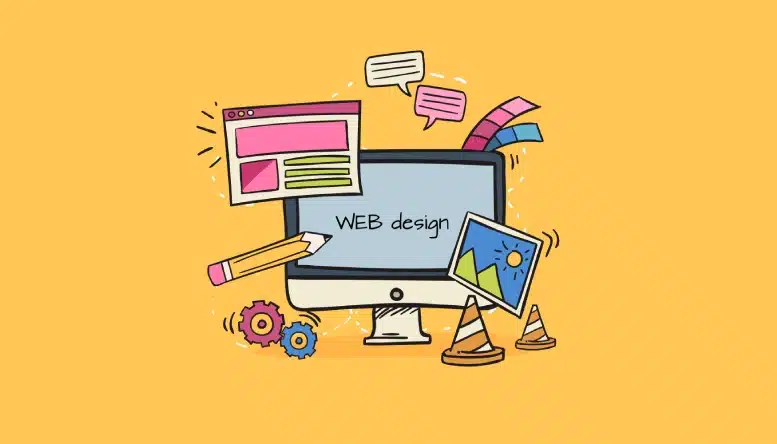The Value of User Experience in Efficient Web Design Techniques
User experience (UX) offers as a foundation in effective web design approaches. It forms just how customers engage with a website, influencing their contentment and likelihood of returning. A well-designed UX can improve engagement with user-friendly navigation and responsive formats. Forgeting these elements might lead to aggravation and raised bounce rates. Comprehending the details of UX is vital for designers intending to develop compelling digital experiences that reverberate with varied target markets. What elements absolutely drive successful user involvement?
Recognizing User Experience and Its Effect On Layout
Although user experience (UX) is frequently viewed as a plain element of web design, it basically forms how customers engage with a website. UX encompasses all aspects of the user's interaction, consisting of usability, ease of access, and overall fulfillment. A favorable UX cultivates involvement, encouraging users to explore the site and return in the future. Alternatively, an unfavorable experience can lead to stress, leading to high bounce rates and shed possibilities for conversion.
Design elements like material, navigation, and format company play important functions in shaping this experience. Effective UX design anticipates user demands and preferences, guaranteeing that info is visually appealing and easily accessible. In addition, recognizing user behavior via analytics can provide valuable understandings, educating design choices that boost functionality. Ultimately, an extensive understanding of UX enables developers to produce internet sites that not only bring in users but likewise promote meaningful communications that straighten with service goals and user expectations.
Key Concepts of Reliable User Experience
Reliable user experience hinges on several essential principles that improve site performance and interaction. User-friendly navigation layout, responsive design essentials, and the relevance of aesthetic hierarchy are important elements that add to a seamless communication in between customers and internet material. Recognizing these concepts allows designers to develop more straightforward and obtainable digital atmospheres.
User-friendly Navigation Design
When individuals run into a web site, intuitive navigating design offers as an essential portal to their overall experience. Effective navigation allows individuals to effortlessly situate the info they seek, improving their communication with the site. Key concepts consist of clear labeling, sensible organization, and constant placement of navigating elements. Labels ought to be uncomplicated, permitting users to anticipate the web content they will discover. A well-structured power structure aids individuals understand the connection in between various areas, leading them through the website effortlessly. In addition, receptive menus and quickly accessible web links add to a fluid experience throughout devices. By prioritizing intuitive navigating, designers can significantly reduce user aggravation and rise involvement, inevitably fostering a positive assumption of the web site and its web content.
Receptive Design Basics
A well-structured navigation system naturally causes the need for a responsive design, which is vital in today's diverse electronic landscape. A receptive layout warranties that websites function effortlessly across different devices, consisting of desktops, tablet computers, and mobile phones. This adaptability improves user experience by allowing content to be easily accessible and visually systematic, despite screen dimension. Trick concepts of responsive style include fluid grids, flexible images, and media questions, which facilitate perfect watching. In addition, prioritizing touch-friendly components improves interaction on mobile phones. By applying a responsive format, developers can suit customers' requirements, reduce bounce rates, and boost engagement. Inevitably, a well-executed receptive layout fosters a positive user experience, urging site visitors to explore the website further.
Aesthetic Hierarchy Importance
Aesthetic pecking order plays an essential function in assisting customers through a site, making sure that important details captures their focus initially. By strategically making use of dimension, spacing, comparison, and shade, developers can develop a clear pathway for individuals to adhere to. Larger components frequently draw the eye, indicating their value, while contrasting shades can highlight contact us to activity. Additionally, constant alignment and group of relevant web content improve comprehension, making navigating intuitive. Effective usage of visual power structure not only enhances functionality however likewise supports the general visual of the website, promoting a favorable user experience. When users can conveniently recognize the most essential information, they are a lot more most likely to engage with the content, leading to boosted complete satisfaction and communication with the site.
The Duty of Usability in Web Design
Functionality plays a crucial function in web design, particularly via navigation simplicity and adherence to access requirements. Efficient navigating boosts user complete satisfaction by allowing site visitors to locate info rapidly and intuitively. On the other hand, conference access standards assures that all individuals, no matter their abilities, can effectively engage with the internet site.
Navigating Simplicity
Simpleness in navigating stands as a keystone of effective web design, greatly affecting user experience. A streamlined navigation system permits customers to discover information rapidly and with ease, minimizing stress and boosting complete satisfaction. Clear labeling and logical structure are crucial elements, leading individuals easily through the web site. Repetitive links or overly intricate food selections can confuse users, causing raised bounce rates. Furthermore, mobile responsiveness has to be taken into consideration, ensuring navigating stays simple throughout tools. Decreasing and prioritizing important web pages mess further sustains user interaction. Reliable navigation not just promotes a favorable experience however additionally urges individuals to explore the website more completely, eventually resulting in greater conversion rates. In this respect, navigating simpleness acts as an essential factor in the overall efficiency of web design approaches.
Availability Specifications
User engagement is greatly enhanced when web sites comply with access criteria, making sure that all customers, regardless of their capacities, can browse and connect efficiently. Conformity with these standards not just widens the target market however also boosts overall user satisfaction. Easily accessible layout includes features such as message options for images, keyboard navigation, and enough color contrast, which help with usage by people with specials needs. Furthermore, implementing these standards can favorably affect search engine optimization (SEARCH ENGINE OPTIMIZATION) by boosting site structure and clearness. As web design advances, prioritizing accessibility comes to be important in fostering a comprehensive digital atmosphere. By accepting these requirements, designers add to a more equitable web, ultimately driving user commitment and engagement.
Relevance of Responsive Design for User Engagement
As consumers increasingly access web sites with a selection of gadgets, the importance of responsive design ends up being critical for engaging customers successfully. Responsive style assurances that a web site adjusts perfectly to various display sizes, providing an excellent watching experience regardless of the device used. This versatility boosts user involvement by helping with easier navigating and communication with material.
When customers come across an internet site that is responsive, they are extra likely to remain much longer, explore further, and return in the future. A well-designed receptive layout minimizes the stress commonly related to scrolling and zooming on smaller displays, consequently decreasing bounce prices. In addition, responsive layout can positively affect internet search engine positions, as search engines focus on mobile-friendly sites. In today's digital landscape, where mobile usage remains to climb, implementing receptive layout is not just advantageous, but essential for preserving user engagement and guaranteeing a positive experience across all gadgets.
Enhancing Load Times for Better User Complete Satisfaction

To improve load times, web designers must prioritize maximizing photos, leveraging web browser caching, and reducing HTTP demands. Furthermore, utilizing Material Distribution Networks (CDNs) can quicken material distribution by distributing it across different geographical locations. Enhancing code, such as compressing CSS and JavaScript data, better adds to quicker loading rates.
Inevitably, a dedication to boosting lots times not only enhances user satisfaction but likewise enhances brand name loyalty and improves the probability of repeat check outs. A swift, smooth experience is crucial for keeping users and cultivating favorable communications.
The Influence of Visual Power Structure on User Communication
Aesthetic hierarchy functions as a vital element in assisting user interaction on an internet site. By arranging material in a method that focuses on info aesthetically, developers can affect just how users browse and engage with a site. This power structure is established with various design techniques, consisting of dimension, color, comparison, and spacing. As an example, larger font styles or vibrant colors accentuate essential aspects, such as calls discover this to activity or headings, while subdued colors and smaller sized fonts can suggest subordinate details.
Efficient aesthetic pecking order helps customers swiftly identify what is essential, decreasing cognitive load and improving usability. It enables user-friendly navigation, making it less complicated for individuals to locate what they require without disappointment. As individuals interact with an internet site, a well-structured aesthetic power structure promotes an extra enjoyable experience, inevitably causing higher interaction and conversion prices. Designers must focus on these principles to develop an user-centered and effective web setting.
Determining User Experience: Strategies and devices

Regularly Asked Inquiries
How Can I Improve My Internet site's User Experience on a Budget plan?
To enhance a site's user experience on a spending plan, one can enhance web page lots rate, simplify navigating, implement receptive design, improve content quality, and gather user feedback for continuous improvements, guaranteeing an enjoyable site visitor experience.
What Are Usual User Experience Blunders to Stay Clear Of in Web Design?
Usual user experience errors in web design consist of cluttered formats, bad navigating, slow packing times, absence of mobile responsiveness, neglecting ease of access, irregular branding, and falling short to focus on user comments - web design company. Each can greatly prevent general website performance
Exactly how Often Should I Update My Website for Better User Experience?
Internet sites need to be updated consistently, ideally every few months, to keep optimal user experience. Frequent updates help address use issues, refresh content, and adjust to altering user requirements, guaranteeing the website stays relevant and interesting.

Can User Experience Impact SEO Rankings on My Internet site?
User experience can considerably affect SEO rankings, as online search engine prioritize websites that offer smooth navigation, fast filling times, and engaging web content. A positive user experience can bring about reduced bounce rates and greater search visibility.
What Duty Does Availability Play in User Experience Design?
Access plays an essential role in user experience layout by guaranteeing that all individuals, no matter of capabilities, can communicate and browse with a site successfully. This inclusivity boosts general complete satisfaction and interaction among varied individuals.
User experience (UX) is frequently viewed as a plain aspect of internet design, it basically shapes how customers connect with a website. User involvement is considerably improved when web More hints sites stick to availability requirements, guaranteeing that all users, regardless of their capabilities, can navigate and engage successfully. Measuring user experience (UX) is essential for comprehending how effectively an internet site meets the demands of its customers. Additionally, usability screening, where actual customers browse the website while onlookers keep in mind difficulties, uses direct responses on user experience. Usual user experience blunders in web design consist of chaotic designs, inadequate navigation, sluggish filling times, absence of mobile responsiveness, overlooking accessibility, inconsistent branding, and failing to prioritize user feedback.